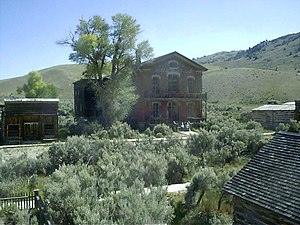Bannack State Park
|
Bannack State Park
|
||
|
Bannack ghost town |
||
| location | Beaverhead County in Montana (USA) | |
| surface | 619 ha | |
| Geographical location | 45 ° 10 ' N , 113 ° 0' W | |
|
|
||
| Setup date | 1951 | |
| administration | Montana Dept. of Fish, Wildlife and Parks | |
The Bannack is 25 km from Dillon in Beaverhead County of the US state of Montana . The state park designated in 1951 consists of the ghost town of Bannack and the surrounding area with a section of Beaverhead Creek . The state park covers an area of 619 hectares at an altitude of 1779 m.
history
Bannack was founded in 1862 and named after the native Bannock Indian tribe . The gold rush town was named the first capital of the historic Montana Territory in 1864. In 1865, during the Montana Gold Rush , the capital was relocated to Virginia City , where since the gold discoveries there in 1863, more and more residents of Bannack have moved. Between the late 1860s and the 1930s, Bannack continued to exist as a mining site , albeit with a declining population. By the 1950s, gold mining yields had continued to decline and most residents had left the city. During this phase, Bannack State Park was established with 40–60 historic structures and buildings. In July 1961, the area was registered as a Historic District as a National Historic Landmark .
fauna
A wide variety of animals have settled in the park and the buildings. While the spotted Columbia frog prefers moist terrain and sparse trees, the western rattlesnake can be found in the dry areas.
The airspace is populated by over 30 species of birds. Songbirds such as the mountain hut warbler , rock wren , cat thrush , gambel tit and black-headed tit , purple blackbird and red-shouldered blackbird can be heard as well as the golden woodpecker and downy woodpecker or screechers like the western forest tyrant . Great blue heron , Grus canadensis , great horned owl and red-tailed buzzard impress with wingspans well over one meter, while the hummingbird species red-backed cinnamon can be only eleven centimeters. Singer vireo , violet tern and belt fishermen complete the range of species
Nocturnal mammals include the long-tailed weasel and several bat species such as the great brown bat , Townsend long-eared bat , and Myotis ciliolabrum and Myotis lucifugus .
In a state park, there are a number of small mammals and rodents like the Dark Rotzahnspitzmaus and cinereus shrew , Thomomys idahoensis , deer mouse , Gull Island Vole and long-tailed vole . Sagebrush vole , Western Hüpfmaus , hiking shrew , or packrat . Mountain cottontail rabbits , dwarf rabbits , donkey rabbits and prairie rabbits live on larger rodents .
Of the squirrels that occur , the Wyoming ground squirrel is one of the cave dwellers, while Tamiasciurus hudsonicus , Yellow Spruce Chipmunk , Little Chipmunk like to roam trees. The Canadian beaver prefers the running waters of Beaverhead Creek . Elk and white-tailed deer are the largest animals in the park. Omnivores such as striped skunks , coyotes and wolverines can feed on this food source .
Individual evidence
- ↑ a b Bannack ( Memento from April 7, 2009 in the Internet Archive )
- ↑ http://www.bannack.org/
- ↑ http://pdfhost.focus.nps.gov/docs/NHLS/Text/66000426.pdf National Register of Historic Places Inventory-Nomination: Bannack Historic District
- ↑ Listing of National Historic Landmarks by State: Montana. National Park Service , accessed August 16, 2019.
- ↑ http://fieldguide.mt.gov/detail_AAABH01290.aspx
- ↑ http://fieldguide.mt.gov/detail_ARADE02120.aspx

